Photo: imghub.ru
On the night of May 28, 1995, an earthquake on the island of Sakhalin completely destroyed the village of Neftegorsk. In less than half a minute, out of three thousand residents of the village, more than two thousand adults, as well as three hundred children, died under the rubble of destroyed buildings and from the fire.
The earthquake on Sakhalin was the most destructive in Russia over the past 100 years . According to various estimates, at the epicenter the force of the tremors reached almost 10 points. After the disaster, Neftegorsk turned into huge, massive ruins, and almost 30 years later, only the graves of the victims and a memorial remained on the site of the city.
History of the city
In the early 60s, oil production developed in the USSR, and it was in the Sakhalin region that new deposits were discovered. The drilling was carried out in a dense part of the forest, where a village called Vostok was subsequently built in 1964, in which oil workers and their families settled. In 1970 it was renamed Neftegorsk.
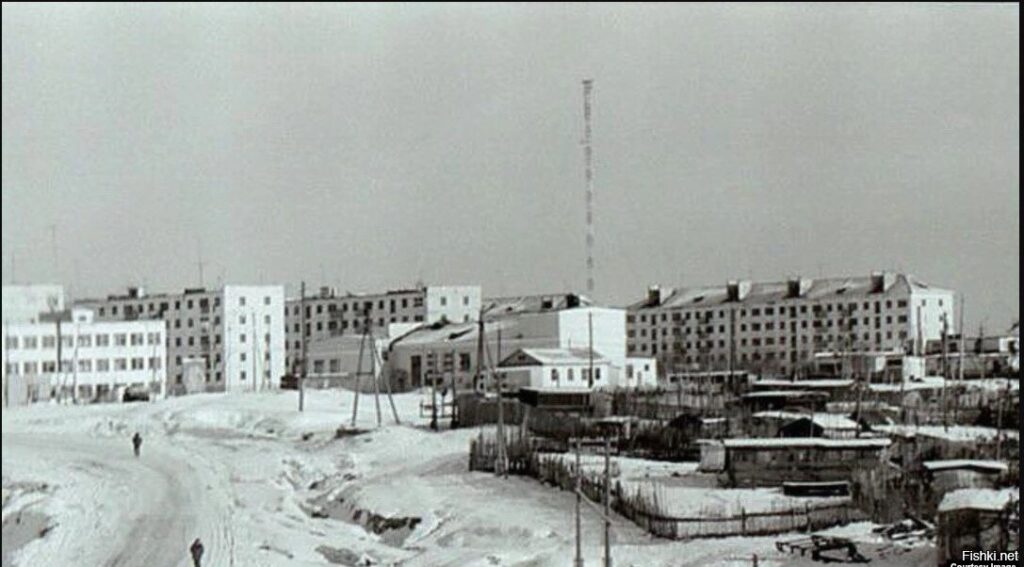
In the village there were several kindergartens, a school, a community center and 17 five-story residential buildings, which were soon folded under their own weight after the earthquake, as they were intended only for a 6-point load system, as it turned out later.
Night of tragedy
“I practically flew up almost to the ceiling. And my daughter was in my arms and also flew up with me. Then they looked: our house collapsed to the west, and the fifth floor turned out to be lower than the first, that’s how it slid to the ground,” said police officer Andrei Glebov, who survived the disaster. During the earthquake he was in his apartment on the fifth floor. The house began to collapse, debris and huge slabs fell from above.
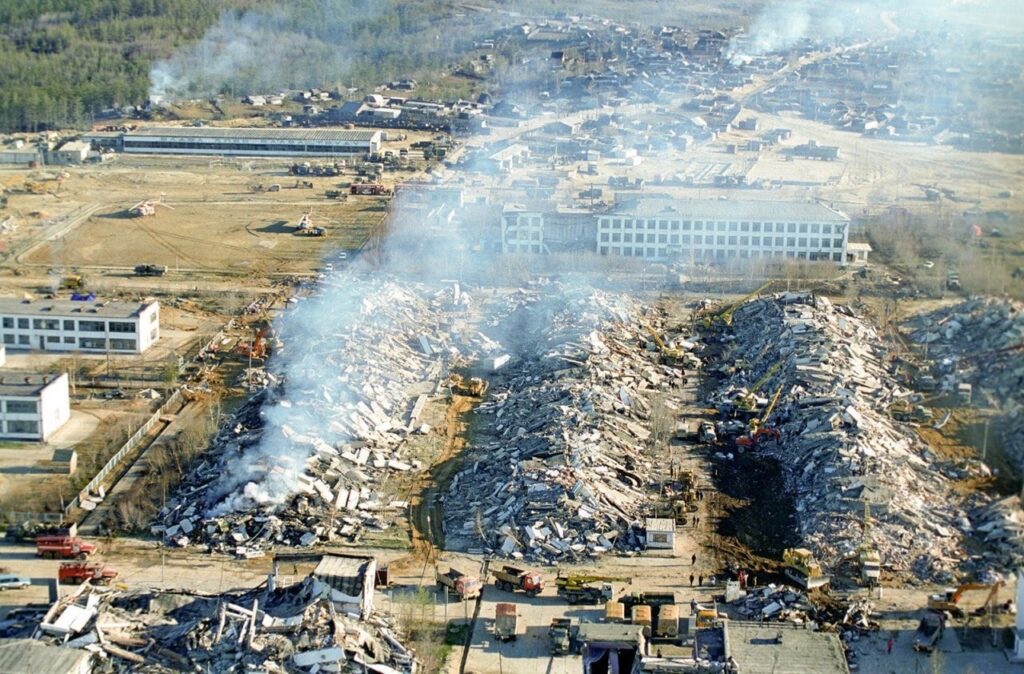
Miraculously getting out from under the rubble, the man got into the car and went to inspect the village: debris was lying everywhere, wounded people stuck under the rubble were screaming and asking for help. It was decided to collect cars from all over the village so that those who managed to survive could take turns warming up in them.
“Before the earthquake, there were parents, friends, relatives, their own small, established, cozy and understandable world. And all this collapsed literally in 17 seconds while the tremors lasted. It’s very difficult to accept: some succeeded, others didn’t,” Andrey shares his memories. Unfortunately, his parents died.
Neftegorsk was located 30 kilometers from the epicenter of the earthquake. After the tremors began, almost all houses collapsed within a few minutes. The gas exploded and a fire started in the village. People were burning alive under the rubble of their apartments, but there were no firefighters and no local doctors. All that remains of the city hospital are ruins. 30 doctors and nurses died under the rubble.
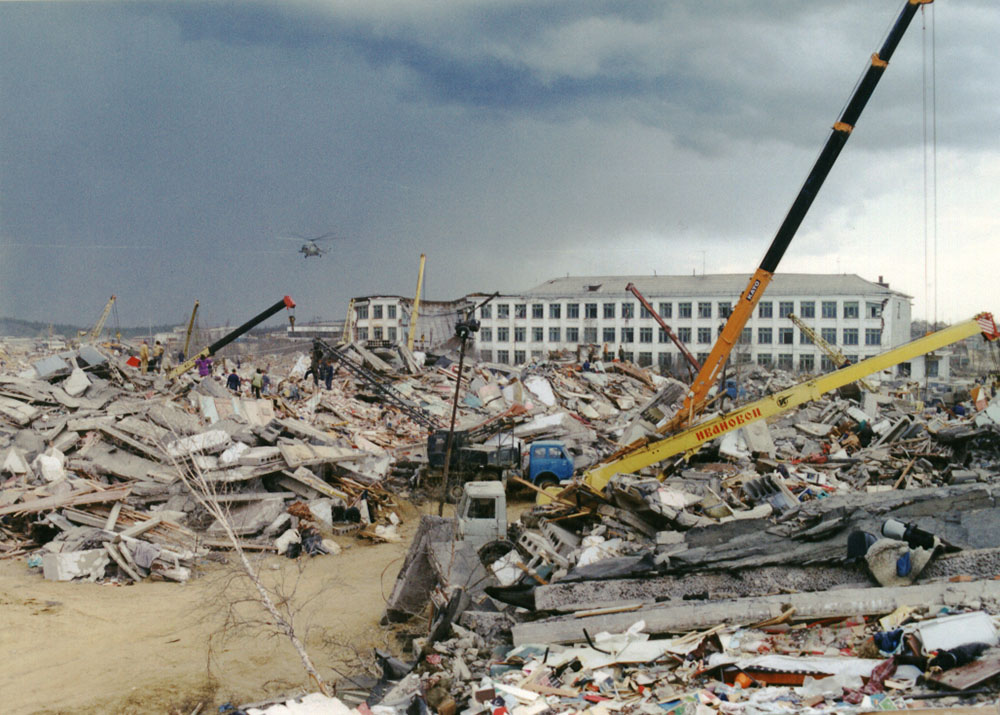
The earthquake took residents by surprise, as it began on the night from Saturday to Sunday, when the townspeople were resting at home. Schoolchildren celebrated their graduation at a local club. Of the 26 young people, only eight survived.
«“ My friend and I went to a disco, which was dedicated to the last call. Around one o'clock in the morning the last dance was announced, and it really became like that for the graduates. My friend and I got stuck between the ceilings. The face was cut. Gradually I dug a hole for myself, where I crawled through up to my waist. They reached us after about four hours. We were taken to the hospital, and I said that first I had to go to the child in the 10th house. They told me that this house burned down. So I lost my sister, mother and little daughter. If they had told me about this right away, I probably wouldn’t have even crawled out from under the rubble,” said survivor Tatyana Lot.
Some residents were saved only because they managed to jump out of the windows in time, but most people were asleep. At 1:04 a.m., people were forever buried under the rubble. In the first hours after the tragedy, the victims used their own strength to pull people out of damaged houses.
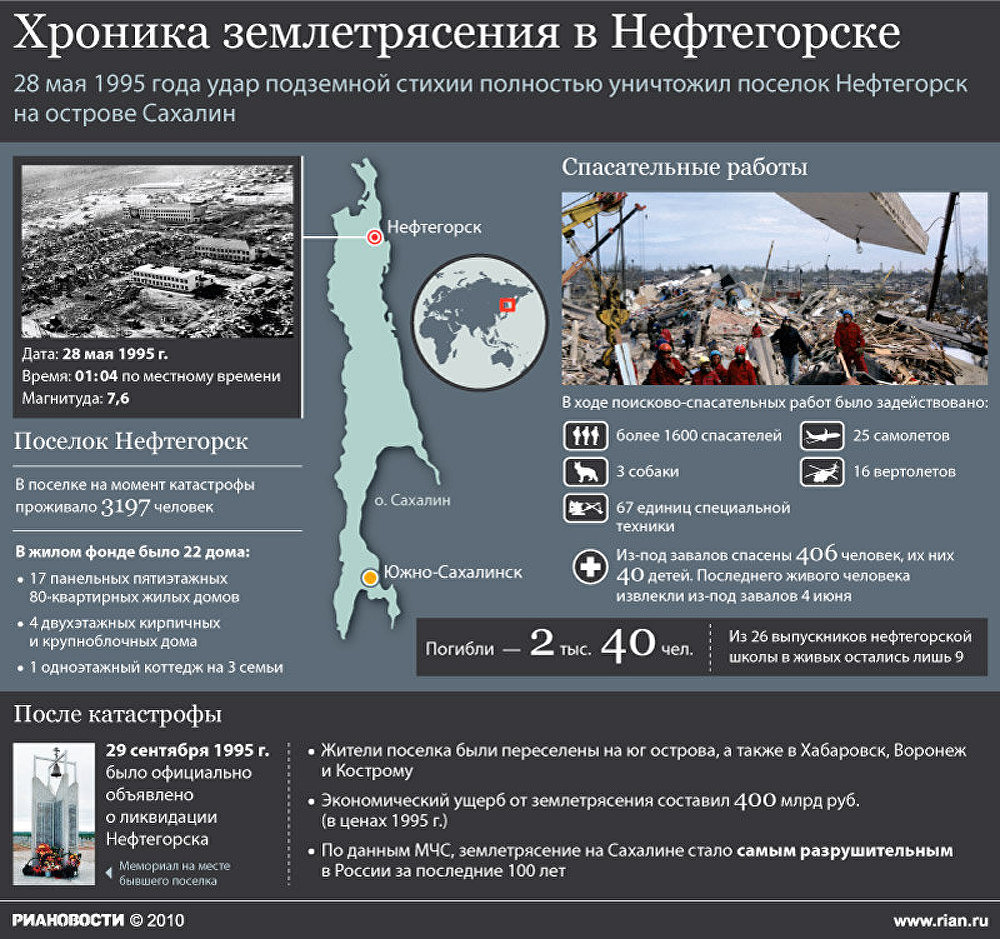
According to the recollections of Andrei Glebov, when he reported what had happened, representatives of the village administration did not believe him. The authorities received information only in the morning, nine hours after the tragedy, and did not have a clear idea of the scale of the disaster.
Carrying out rescue operations
On May 28, rescue work began in Neftegorsk. 190 units of ground equipment, 25 aircraft and 15 helicopters arrived at the scene of the tragedy. More than a thousand people worked to clear the rubble. Military and rescue workers from remote regions were sent to Neftegorsk.
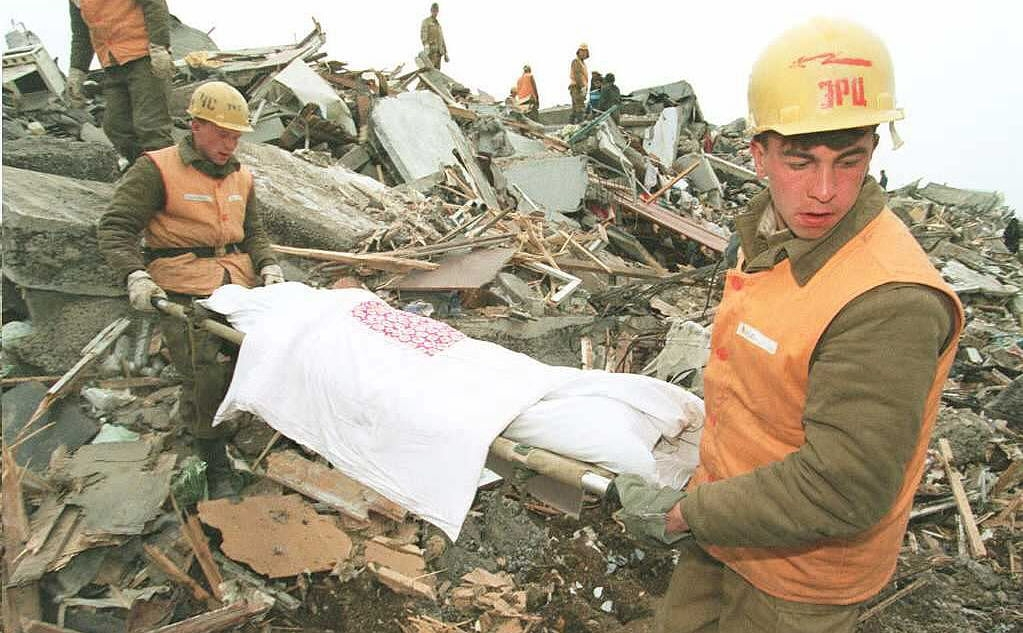
In the first two days, more than 500 people were rescued from the rubble, but many did not survive due to serious injuries. According to rescuers, they had to saw off body parts alive in order to reach pinned or stuck people.
Roads were destroyed and the wounded were transported by air. Rescuers put their lives at risk, because the slabs could collapse at any moment.
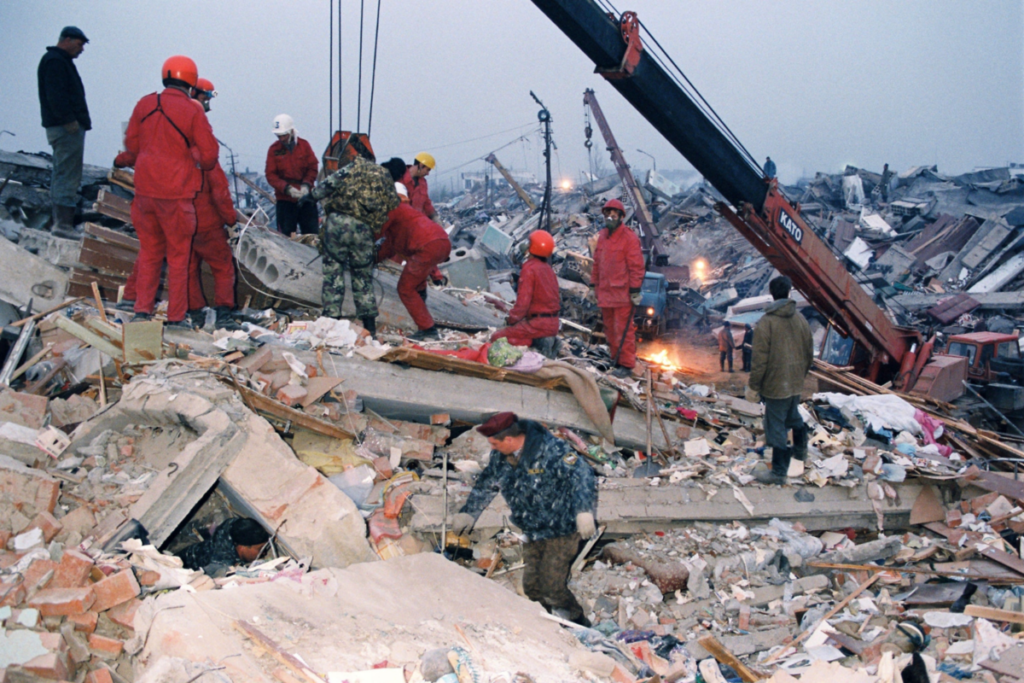
Hour of silence
A few days after the tragedy, it was decided to use the “hour of silence” for the first time in history. All equipment stopped: bulldozers and cranes were turned off.
Rescuers walked around the destroyed buildings, listened to every rustle and cry, and then rescued the victims. It was after the earthquake in Neftegorsk that an hour of silence was introduced in the world for rescue operations.
Очевидцы трагедии, те, кто остался в живых, как вчера помнят те тяжелые дни, которые переживали под завалами.
“I lost consciousness, when I woke up, it seemed to me that we were spending the night at the dacha. A hut of slabs and boards formed above me, and in the distance I saw some kind of opening. And I lost consciousness again. When I woke up for the second time, I already heard screams and saw the glow from the fires,” says Tatyana Walter. She is a native resident of Neftegorsk, and at the time of the tragedy she was only 10 years old.
“My grandmother was in shock; she thought that one of our houses had collapsed. She suggested: “Now let’s go to your father, we can’t spend the night on the street.” And I tell her: “Look around.” And there is nothing around, only dust and smoke. Everyone tried to find their own, but no one abandoned their neighbors.”
After 12 days of rescue operations, the last man alive was rescued. During the earthquake, he fell into the basement, where he had some food and water. Thanks to this, he was able to hold out for so long.
The victims were taken for treatment to different cities of the USSR. The damage caused by the disaster is estimated at several hundred billion rubles. They decided not to rebuild Neftegorsk.
Now on the site of the city there is a memorial plaque with the names of the victims. There are memorial plaques under which are buried the ashes of unknown people who were burned alive.
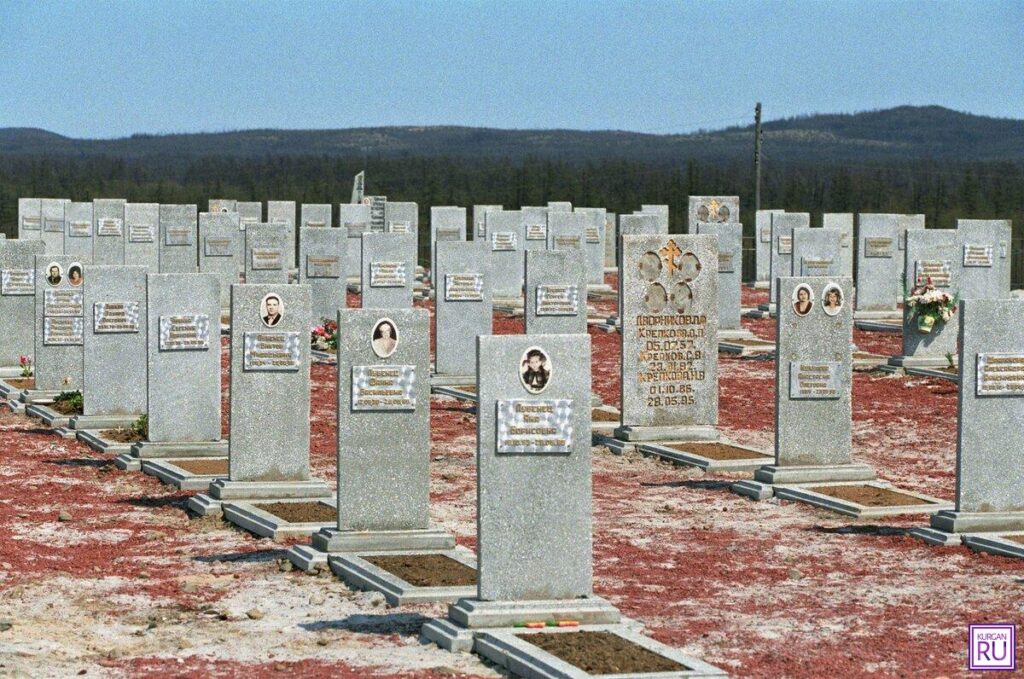
On October 6, 1995, the city ceased to exist; it was as if wiped off the face of the earth along with the city residents, children, workers, and old people. The remaining collapsed buildings are covered with earth. Now people return to the site of the village only on earthquake anniversaries.
Life after tragedy
Former residents of the now defunct village have dispersed across the island and throughout Russia, but do not lose sight of each other. Many people meet in life and come to a city that no longer exists, to their relatives or to those they once knew.
slander Evgeniy, who now lives in Yuzhno-Sakhalinsk, went to Neftegorsk as a volunteer after the earthquake to help clear away the rubble, look for the bodies of the dead, and was eager to try to hear the voices of the survivors.
“Six months later, on November 28, 1995, Khabarovsk took the initiative to resettle the Neftegorsk residents. Several houses were built, some were given certificates for a certain number of square meters to which the housing corresponded,” says Vasily Bucerka, who also took part in the rescue operation.
“The first seven years were the most difficult, then somehow everything slowly began to fall into place. I had to look for work in a new way. Many of us, due to the stress, created new families with those who all died. We have a lot of such cases. Some meaning of life was lost. I had to recover bit by bit and look for some new path in life,” Svetlana Parshina, who was 24 years old at the time of the tragedy, shared her story
Author of the publication “The Word is Ours!”
I go to the theaters, I love literature, I develop culturally, I absorb any information.
